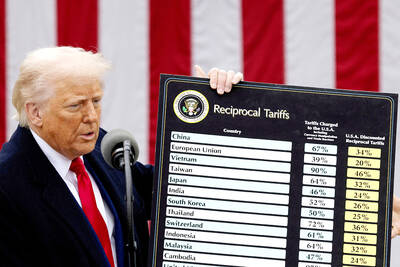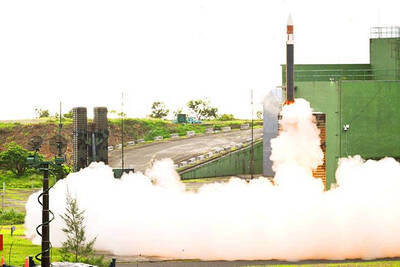Taiwan is not part of the People’s Republic of China (PRC), the government, the Democratic Progressive Party (DPP) and the Chinese Nationalist Party (KMT) said separtely yesterday, responding to a joint statement by China and Myanmar on Saturday.
According to the statement issued as Chinese President Xi Jinping (習近平) wrapped up a two-day visit to Naypyidaw, which was posted on the Chinese Ministry of Foreign Affairs Web site, Myanmar said that it firmly adheres to the “one China” principle and recognizes Taiwan, Tibet and Xinjiang as inalienable parts of the PRC’s territory, and that it supports Beijing’s efforts to resolve issues relating to Taiwan, Tibet and Xinjiang.
Beijing’s forceful push for its “one China” principle is not beneficial to cross-strait relations, and harms regional peace and stability, Presidential Office spokesman Ting Yun-kung (丁允恭) said.
China should be aware of the will and voice of Taiwanese, and give up its threats and efforts to suppress Taiwan, Ting said.
Only by doing so could cross-strait relations develop in a positive direction, he added.
“The Ministry of Foreign Affairs [MOFA] solemnly protests the joint statement issued by China and Myanmar on January 18, in which Myanmar reaffirmed the so-called ‘one China principle’ and categorized Taiwan as an inalienable part of the People’s Republic of China’s territory,” ministry spokeswoman Joanne Ou (歐江安) said.
“The ministry condemns such false statements that diminish the sovereignty of the Republic of China, Taiwan,” she said.
Taiwan is not part of China, and only the Taiwanese government elected by its people can represent Taiwan in the international arena, she said.
“The results of the [Jan. 11] elections fully demonstrated the will of Taiwanese in resisting China’s ‘one country, two systems’ model,” Ou said.
“China’s rude and unreasonable promotion of the fabricated ‘one China’ principle will only hurt the feelings of Taiwanese and force democratic Taiwan to draw a line with autocratic China,” she added.
Beijing should respect the results of the presidential and legislative elections in Taiwan, which gave President Tsai Ing-wen (蔡英文) a second term in a landslide victory, Ou said.
DPP spokeswoman Lee Yen-jong (李晏榕) said that China must curb its campaign to exclude Taiwan from participation on the international stage if it wants to return to a normalization of cross-strait dialogue.
“As the joint statement has infringed upon Taiwan’s sovereignty, we disagree with it,” she said.
“Taiwan has just finished its presidential and legislative elections. All nations and media were clear the election outcome was the strongest message by Taiwanese in saying ‘no to China,’ but China continues to ignore the real voice of Taiwanese,” she said.
China should end its political machinations and stop pressuring the international community to exclude Taiwan, she added.
The KMT said that the joint statement’s stance on Taiwan was “regrettable” and that it “could not agree with it at all.”
It has always believed that “one China” refers to the Republic of China (ROC) established in 1912 … which has independent sovereignty, although its jurisdiction is currently restricted to Taiwan, Penghu, Kinmen and Matsu, the KMT said in a written statement.
“Taiwan is definitely not a part of the PRC,” it said. “Authorities in the mainland should deal with the matter pragmatically.”
The joint statement’s stance on Taiwan is not only “unacceptable” to Taiwanese, but not helpful to cross-strait relations, it said.
The KMT is committed to safeguarding the ROC’s sovereignty, it added.

WAITING GAME: The US has so far only offered a ‘best rate tariff,’ which officials assume is about 15 percent, the same as Japan, a person familiar with the matter said Taiwan and the US have completed “technical consultations” regarding tariffs and a finalized rate is expected to be released soon, Executive Yuan spokeswoman Michelle Lee (李慧芝) told a news conference yesterday, as a 90-day pause on US President Donald Trump’s “reciprocal” tariffs is set to expire today. The two countries have reached a “certain degree of consensus” on issues such as tariffs, nontariff trade barriers, trade facilitation, supply chain resilience and economic security, Lee said. They also discussed opportunities for cooperation, investment and procurement, she said. A joint statement is still being negotiated and would be released once the US government has made

Authorities have detained three former Taiwan Semiconductor Manufacturing Co (TMSC, 台積電) employees on suspicion of compromising classified technology used in making 2-nanometer chips, the Taiwan High Prosecutors’ Office said yesterday. Prosecutors are holding a former TSMC engineer surnamed Chen (陳) and two recently sacked TSMC engineers, including one person surnamed Wu (吳) in detention with restricted communication, following an investigation launched on July 25, a statement said. The announcement came a day after Nikkei Asia reported on the technology theft in an exclusive story, saying TSMC had fired two workers for contravening data rules on advanced chipmaking technology. Two-nanometer wafers are the most

NEW GEAR: On top of the new Tien Kung IV air defense missiles, the military is expected to place orders for a new combat vehicle next year for delivery in 2028 Mass production of Tien Kung IV (Sky Bow IV) missiles is expected to start next year, with plans to order 122 pods, the Ministry of National Defense’s (MND) latest list of regulated military material showed. The document said that the armed forces would obtain 46 pods of the air defense missiles next year and 76 pods the year after that. The Tien Kung IV is designed to intercept cruise missiles and ballistic missiles to an altitude of 70km, compared with the 60km maximum altitude achieved by the Missile Segment Enhancement variant of PAC-3 systems. A defense source said yesterday that the number of

Taiwanese exports to the US are to be subject to a 20 percent tariff starting on Thursday next week, according to an executive order signed by US President Donald Trump yesterday. The 20 percent levy was the same as the tariffs imposed on Vietnam, Sri Lanka and Bangladesh by Trump. It was higher than the tariffs imposed on Japan, South Korea and the EU (15 percent), as well as those on the Philippines (19 percent). A Taiwan official with knowledge of the matter said it is a "phased" tariff rate, and negotiations would continue. "Once negotiations conclude, Taiwan will obtain a better